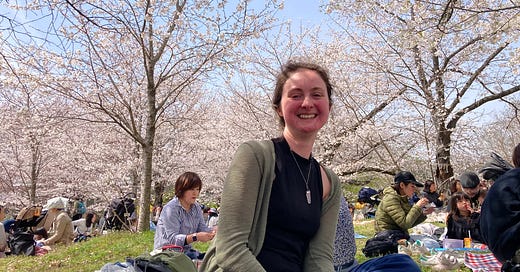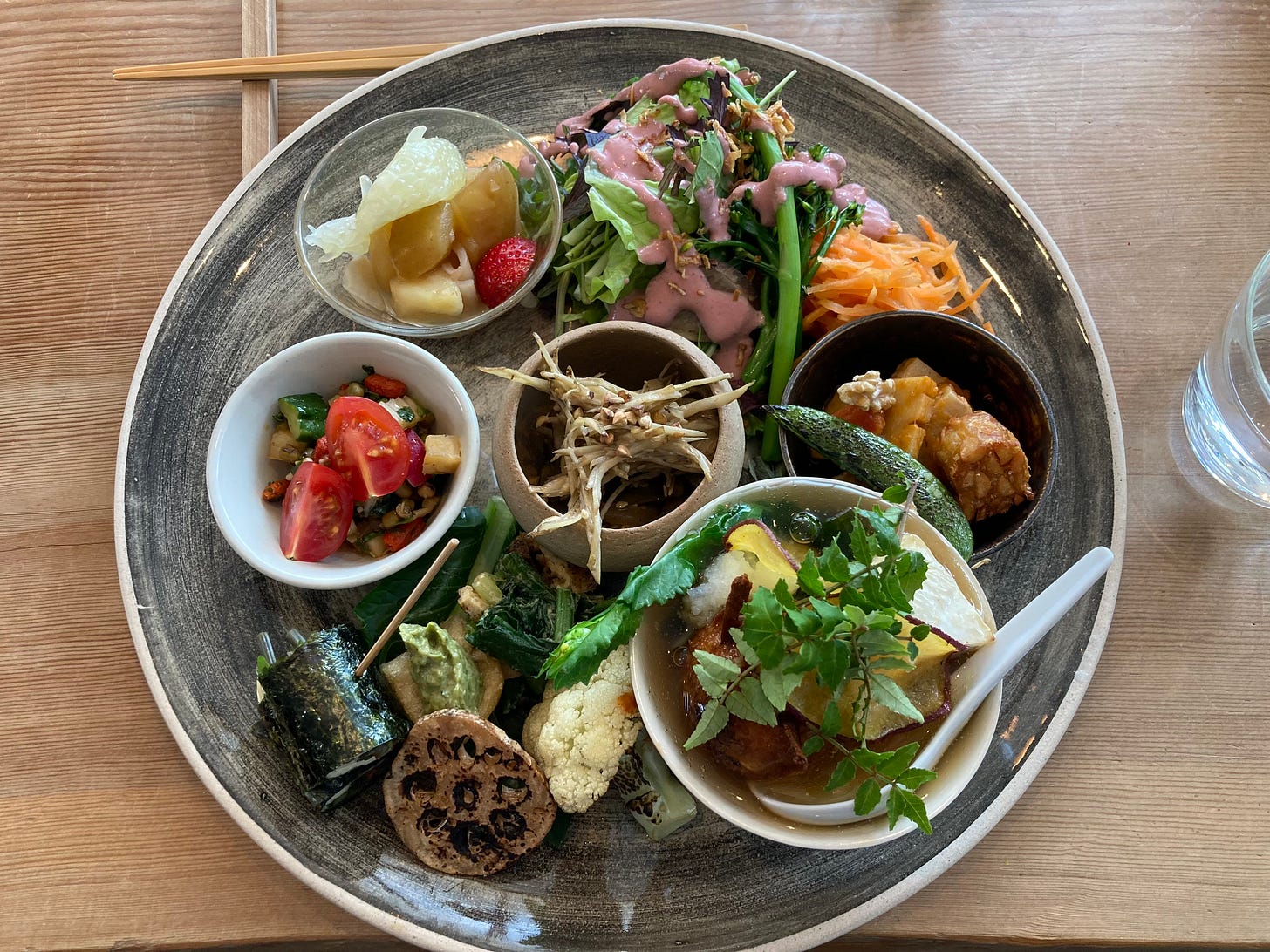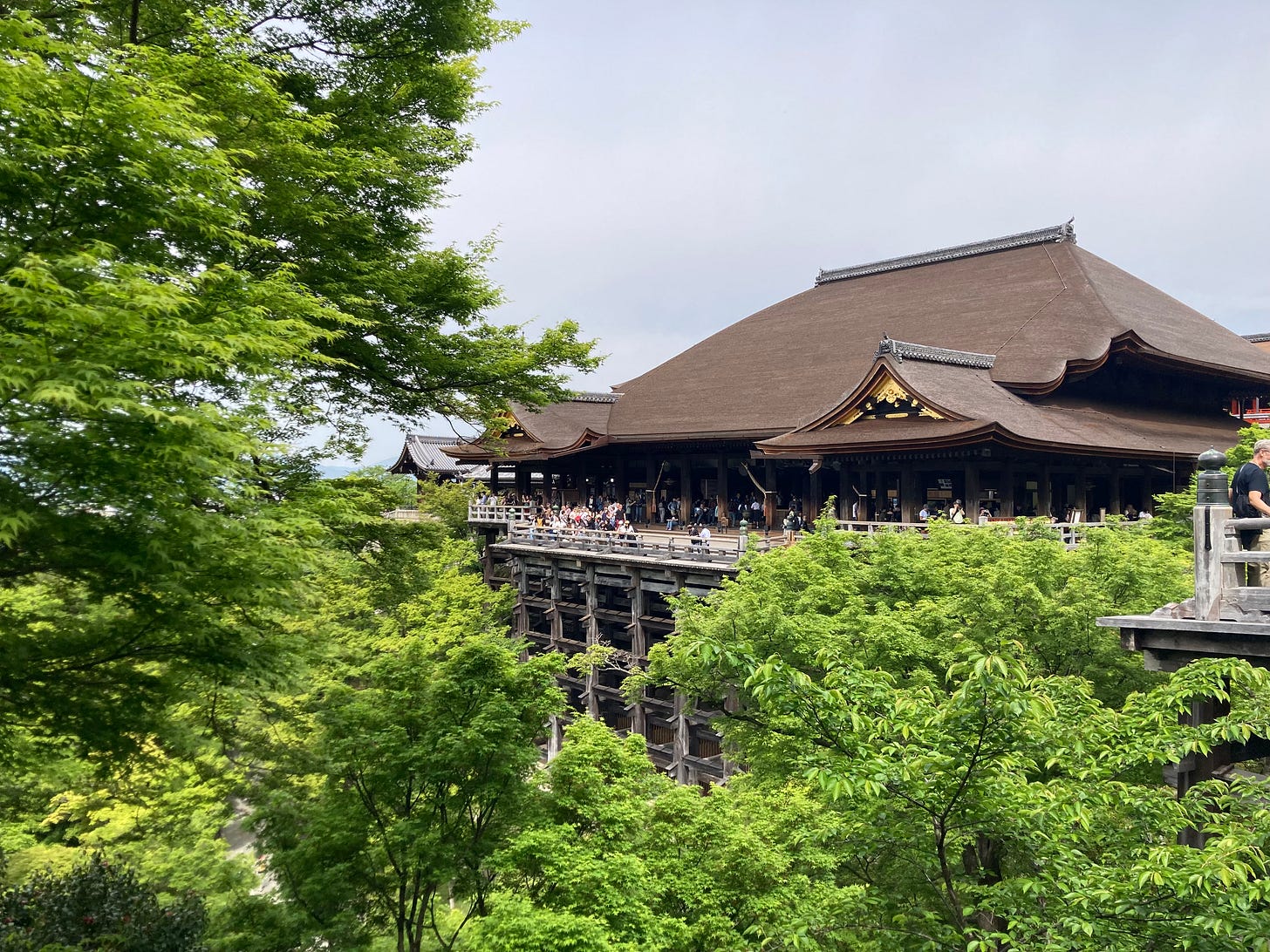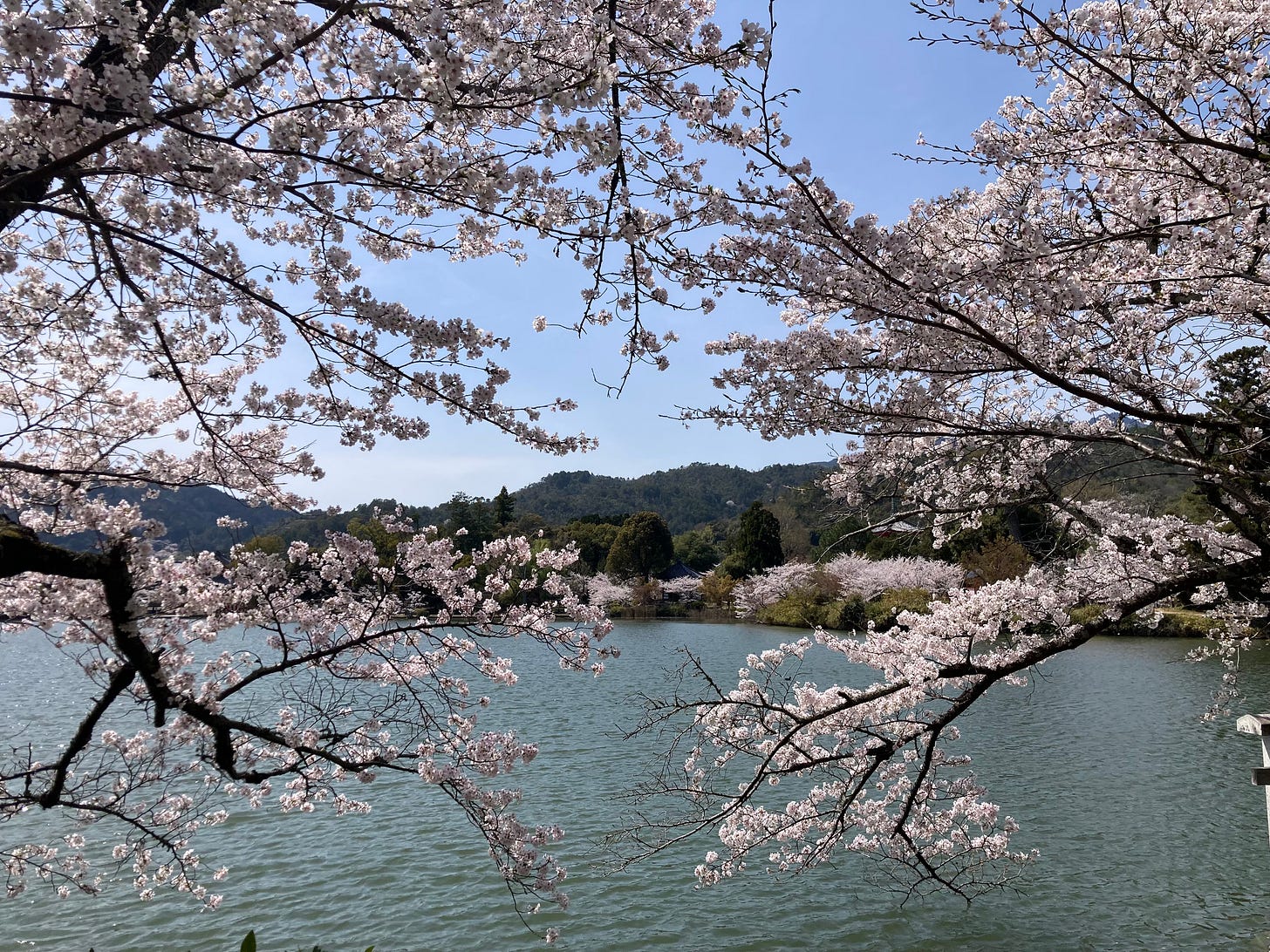I recently returned from a month solo travelling in and around Kyoto, and I have so much I want to share about my time there. Consider this the first instalment of what I am sure will be many lengthy blog posts.
Today I want get into my experience of being an AuDHDer in Japan - what I found easier, and what was more difficult.
Let’s start with the positives.
ND friendly aspects
(Note - this is written based on my experience as an AuDHDer. We are all different, so this will not be an accurate reflection of everyone’s experiences)
Respect for personal space
This comes with the important exception of busy public transport (more on that later).
In general, consideration is key. People seem to be far more aware of the space they are occupying and ensuring this is not impacting anyone around them.
I noticed this particularly in busy supermarkets where there seemed to be an intricate dance going on of trolleys, baskets and avoiding reaching across others at all costs. Minimal physical contact is preferred, which suits me just fine.
On public transport everyone was careful to ensure that their bags were neatly on their laps or in front of their bodies. The slightest accidental contact with anyone was quickly followed by an apology ‘すみません’. There was no risk of any brushing of shoulders or legs when you sat down next to someone.
Light touch is just the worst for me, so this was such a blessing.
Scripted conversations
If you’re going into a supermarket, a convenience store or a restaurant, you can rely on the same scripted conversations.
The same questions will be asked, the same greeting phrases ‘いらっしゃいませ’ and thank yous ‘ありがとうございました’ . There’s a comfort in the predictability of what to expect from each of these interactions.
I love the language, so I spent some time studying these interactions before I left. Even still, I drew a blank when someone first asked if I had a point card, or needed a shopping bag. However, it was easy to then look this up and add it to my memorised phrases for next time around.
Indirect eye contact
Possibly my favourite aspect. Indirect eye contact is the norm in Japan. It’s actually considered rude and/or intimidating to give direct eye contact - finally a country that gets it!
It felt like such a welcome break to not have to think about maintaining eye contact in conversations.
It’s amazing how much energy and cognitive load this freed up in me to then be able to really listen. I find eye contact very distracting, and far too intimate when it’s with strangers.
Eating lots of small dishes
I was recently introduced to the concept of a ‘dopamine lunch’ - a selection of different foods on your plate that you can move between for variety of taste and texture.
I’ve always thought of this as a ‘picky lunch’, and it’s my favourite way to eat. Think tapas, mezze, or in this case Japanese set lunches. As a bare minimum you’ll get a main dish, a side of rice, a dish of pickles, and a miso soup. Already plenty of different tastes and textures to enjoy.
I usually get bored whilst eating, but this never happened in Japan because there was always something new to try, or a different flavour to visit.
I do eat with my eyes, and so many of these meals were so beautiful even just to look at. This one below was my favourite, and tasted even better than it looked. I mean it’s a work of art.
Did I know what I was eating? Nope, not always. Was that a problem? Not for me!
Side note - yes, it is possible to be vegan in Kyoto and I will most likely write a whole post on food because it was just too good.
Beautiful, efficient systems
Is there anything more satisfying than systems that have been well thought through?
The answer is no, no there isn’t. But that’s coming from someone who has a real thing about efficiency. I’m the sort of person who will wait to go upstairs until I can think of at least 3 reasons to go up there…
There are so many examples of this in Japan. Whether it’s clever packaging (onigiri I’m looking at you), queuing at bus terminals, restaurant vending machines*, or checkouts at the supermarkets.
Everything has been carefully considered to make life as easy as possible.
The supermarket systems really stood out to me. At the Izumiya I visited on pretty much a daily basis the checkout staff would scan your items, moving them from your basket to an empty one on their right. Of course, they would carefully place each item far more neatly than it originally went in. Once scanned, they would direct you to a separate self checkout to pay. Then you’d take your basket over to the packing section to pop it all in bags.
What’s the big deal with that?
Well, it means no anxiety induced frantic packing as someone inevitably scans faster than even the most skilled Tetris player can pack. It also means no delays whilst someone struggles to find their purse or hands over a load of coins.
It took all the pressure off the situation, and that is a wonderful thing.
*extra love for these because it means you don’t even have to speak to anyone to get your food, simply hand over a ticket. Ideal for days where people-ing is too much.
The toilets
No. Seriously.
Cold mornings in England for me are sensory nightmare. Sitting on a cold toilet seat sends a shock through my whole body and I hate it.
Japanese toilets have heated toilet seats, and not just in the hotels…every public toilet I visited had heated seats!
Not only this, the majority were remarkably clean (not at tourist hot spots). In the UK I am used to walking into a public toilet and immediately walking out again, deciding I don’t need it enough to manage the smells and other horrors.
I also never had to worry about not being able to find a toilet as there are so many free public toilets dotted around, even in remote temple locations.
Quiet
Even in some of the busiest locations (see the cherry blossom picnic spot at the beginning) it was not overly loud.
Japanese people tend to speak quietly, always conscious of not disturbing others around them. Shouting is rare, in fact I only remember one occasion where a shop assistant yelled out, and chased down, a customer who had accidentally left 10 yen of change (less than 5p for context…)
Sure, there are some excited exclamations thrown around, particularly with the cherry blossoms and yummy food, but none came as a jolt or a shock.
Speaking on the phone in public also seems to be a taboo - certainly on public transport. There are also no loud conversations with friends walking down the streets. There’s a gentle hubbub of noise without any dominating voices.
If I needed a break from the busier parts of downtown Kyoto, I could easily stumble upon a shrine or temple and sit for a few moments in the peace and quiet.
I’m so used to wearing my noise cancelling headphones when I’m out and about in London. I didn’t feel the need for them in Kyoto.
The more challenging parts
Crowded public transport
Remember what I said earlier about personal space? Yeah, throw that out the window if it’s rush hour or a popular bus route. Then, the considerate thing to do becomes making sure as many people as possible can get on the bus/train/tube.
It’s not quite the London Underground level of sardines, as people are still thoughtful about not shoving an armpit in your face. Plus when it comes to getting off you feel a little like Moses parting the seas. However, for someone that values personal space, it’s a lot.
Also, even when it was 28 degrees outside the heating was on in the bus! What’s that about? This did not help with the already creeping overwhelm of too many people in too small a space.
Visual overload in shops
Probably the closest I came to a public shutdown.
I’d been up to the 4th floor of a large shopping centre to get a new pair of glasses from JINS - eye tests in a foreign country are great fun (no sarcasm here). I went back down to what I thought was the floor with the exit to street level and couldn’t find my way out. Panic started to set in.
I looked around and found myself completely surrounded by electronics. Everywhere I looked were advertisements, posters, signs, products…but no exit signs. There was so much visually to take in that I could feel myself becoming incredibly overwhelmed.
I resorted to my well known coping strategy of looking at the floor whenever possible. Taking a few slower breaths I worked out I must be on the wrong floor and made my way up the escalator again.
Thankfully, I landed in the right place this time and walked/ran out towards the daylight.
This experience is why I avoided Don Quijote like the plague. Just looking at pictures on google maps made me feel anxious. I can’t take that much visual information all at once.
Overlapping sounds
This is as problematic for me as too much visual information. Unfortunately, these two often come hand in hand in Japan.
It was the same shopping centre that also had competing music playing from different stores. Then add audio advertisements and announcements over the top of that and it’s not exactly a symphony.
I can’t filter out individual sounds in these environments. What may be ‘background noise’ to others is a cacophony of conflicting noises that are all out of sync with each other. If I can hear two different pieces of music playing at the same time, I will quickly get a headache.
So I removed myself from the situation.
Tourist hot spots
Let me stress that this doesn’t have anything to do with Japan itself, and everything to do with my own irritation at people who are not respectful to the country they are visiting.
In my eyes, when you visit somewhere on holiday you are a guest in that country and should do your best to be considerate to the culture you find yourself in.
In Japan, that means taking your rubbish away with you, not throwing it into the canal on the philosopher’s path.
It means paying attention to the signs that say no photography, and not doing photoshoots down the preserved historical streets and Geisha districts.
It means not moonwalking along the wooden floors at a Zen rock garden.
It means being mindful and considerate of all the other people who are visiting a location and would like to take a photo. You may have to wait, you may have to be quick, and you really shouldn’t elbow your way through.
It means at least trying to speak some of the language (at least please and thank you), rather than half shouting English at people and getting frustrated when they don’t understand.
Ok.
Breathe.
Rant over.
After ‘should-ing’ myself about specific locations I ought to visit and getting overwhelmed by crowds of tourists, I instead followed my instincts. I let my inner adventurer take the lead and found many beautiful secret spots that felt closer to the real Kyoto.
The many unspoken rules
As someone who experiences rejection sensitivity, I couldn’t bear the idea of accidentally insulting or upsetting people. I researched Japanese etiquette in advance of my trip, did my best to observe how others around me behaved and followed their lead.
I still managed to offend someone on my very first day, and got tutted at. I’m sure a lot of you will understand that this then stayed with me for days.
I was incredibly jet-lagged and looking for somewhere nearby to get some lunch. I noticed there was a restaurant on the 5th floor of building and walked over to the lift. There were two older Japanese women already in the lift who stood either side of the doors and pressed the buttons for the floors they needed.
I waited to see which they pressed and realised mine wasn’t selected. I slowly stepped forwards and reached across to press the button. The woman behind me tutted immediately and of course I realised my mistake. I should have at least said excuse me ‘すみません’ or asked for the 5th floor.
This is just one of many unspoken rules, that can feel like pitfalls for tourists. Others include accepting business cards with two hands, and never sticking your chopsticks into your food or pointing them at others.
Then there’s the indirect communication. You don’t just say no to an invitation you can’t make, you start to say that it’s a little tricky and leave the rest unsaid. A lot is left to be interpreted in body language which could be a minefield for ND folks.
If you’re curious about other examples of this, or doing your own research, this is a good site to take a look at:
https://culturalatlas.sbs.com.au/japanese-culture/japanese-culture-communication
So was it easier in Japan?
Well, it’s complicated.
I felt like managing my sensory needs was generally easier, and my ADHD had a great time exploring and trying lots of new foods.
There were also times though when I felt my self monitoring and masking going up to levels I didn't think were possible.
I had to use a lot of cognitive energy navigating situations whilst trying not to offend or be too direct.
Would I go back again?
In a heartbeat!







Also AuDHD and would truly love to visit Kyoto one day. Thank you for all this information. It’s quite helpful to know what it’s actually like for another person like me. Also, I’m disabled. I use a wheelchair. Did you notice if Kyoto is at all wheelchair accessible? I’ve always wondered.